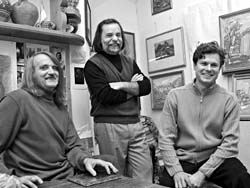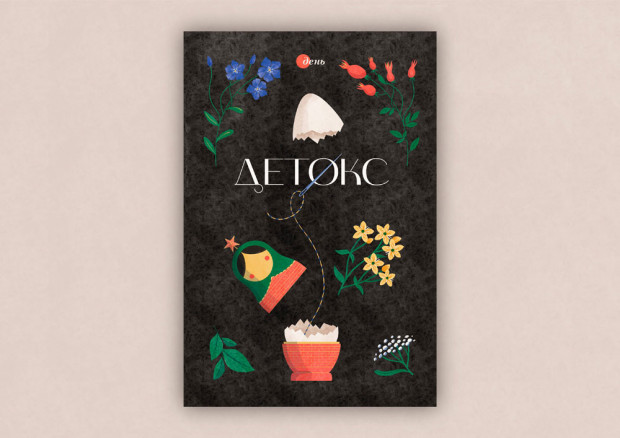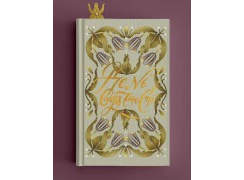“Everyone has a Potashnia in his heart”
Series of paintings dedicated to Ukrainian village phenomenon
“We want to express our gratitude to the artists who love Podillia for their rich colors, memories of summer, good mood, and positive emotions and energy! We will share our great impressions in Lviv,” reads an entry in the guest book signed by 20 young Lviv residents after exploring the smash exhibit “Potashnia, the Gem of Podillia” (Ukrainian countryside phenomenon), at Taras Shevchenko National Museum in Kyiv.
“We thank you for everything we saw; it is unforgettable. A wonderful combination of man and nature...Special thanks for the warm and bright colors of hope; for showing that, apart from the routine city, there is the Ukrainian village with its truthful history and culture” reads an entry signed by Oksana and Oleksii Musiienko. A group of students from Kyiv National Trade and Economics University summed up their impressions this way: “It is amazing to see works created by different artists painting the same village; they reflect the entire inimitable culture of Ukraine.”
This series of works is displayed in the studios of two artists, Volodymyr Harbuz and Vasyl Korchynsky. The paintings are hung on the walls, one next to the other. Watching them, one sees an arresting panorama of the Podillian village of Potashnia unfolding: ripe red apples in a late twilight setting. “For me this broad and fertile apple tree is associated with my childhood,” says Korchynsky. “There was an old broken-down bed under such a tree in my native village, and I loved sleeping there in the summer. How well I slept in it, what sweet dreams I had!”
Over there are old ramshackle village homes overgrown with mallows, and the endless fields reach beyond the horizon.
“Prokip Kolisnyk, the author and curator of the Potashnia exhibit, is a noted painter,” says Oles Solovei, one of the participants along with Levko Voiedylo, Oleksandr Kharvad, Ivan Salevych, Ihor Yuriev, and Mykola Bondar. Kolisnyk lives in the Slovak city of Presov (Priashiv) and teaches at the local university. He visits Ukraine several times a year and always visits Potashnia (Bershad raion, Vinnytsia oblast). It hurts him to see this village falling into decay, with closed clubs and libraries, and the bookstores converted into snack bars. Young people are taking to the bottle and older residents are dying. Three years ago Kolisnyk started digging in the archives and discovered that his native village was almost 300 years old.
That was when he conceived the idea of converting the ramshackle lord’s palace into the village’s local history museum complete with an art gallery. He decided to start with plein air, inviting artists capable of absorbing and conveying the village’s energy, and in doing so becoming information carriers. To carry out his project he secured support from the head of the village’s agricultural firm, Valerii Falileiev, who saw a patriot in Prokip and one who means business. Kolisnyk would often joke: “What do we need Paris for? We have Potashnia, that’s Paris for you! Everyone has his own Potashnia in his heart. Volodymyr Harbuz has Karypyshi in Kyiv oblast; Vasyl Korchynsky has Vovchok in Vinnytsia oblast; I have Yareshky in Zhytomyr oblast. Each one has sources to which he returns.”
So they started with plein air. According to the artists’ descriptions, the Southern Buh River is some 30 kilometers from Potashnia. The village is surrounded by oak forests on three sides. This feature is reflected in the local architecture: gates, doors, fences, and passages are markedly archaic (four-sided pillars with carved patterns ornamenting the perimeter) and reminiscent of forms seen in the times of Kyivan Rus’.
The scenic ravines, gardens, and fields are something an artist can only feast his eyes on. The project participants recall local residents visiting them when they were working on their plein air canvases, treating them to honey, bread, meat, tomatoes, and plums — and carefully examining their progress. At first they would be amazed: how can people paint from dawn until late evening, when it is time to work in the vegetable garden and do other domestic chores? And then they became enchanted by the artists’ work. People living in the countryside tend to adopt a rational approach to work. “When I visited the place for the first time,” recalls Korchynsky, “I started painting old willows at six in the morning. An old woman walked up, looked at my canvas, then at me, and said: ‘You haven’t been here before.’ This is proof that the people here are keeping track of all their visitors, and they find these visits interesting.”
After the end of every plein air session, an exhibit of new works has been held for the past three years at the village art gallery located on the premises of the renovated lord’s palace. The opening ceremony is attended by the poets Vasyl Herasymiuk and Ihor Rymaruk; composer Oleksandr Smyk; sculptor Ivan Salevych; kobzar Taras Sylenko; woodcarver Valerii Bondar; and the Pysanka Duet.
New items are constantly being added to the village history museum. People are bringing pieces of decorative and applied art dating back 30-40 years. In other villages, rugs, ceramic pieces — even icons — are dumped or given to whoever wants them for free. This village museum is much better stocked than the raion one. Harbuz believes this is why they do not want to register it legally.
“The village of Potashnia is still alive, although hard times may be ahead,” says Korchynsky. “In Lisnyche, a village in Vinnytsia oblast, 60 people died last year and four babies were born, which is a significant statistic. You can see abandoned homes with boarded up windows. It is painful to think that a whole cultural stratum may be lost, so we are making every effort to portray all this.”
In fact, owing to the efforts of dedicated people, including local residents, Potashnia has become a vital center of culture. Vasyl Korchynsky correctly notes that every village would be lucky to have an enthusiast like Prokip Kolisnyk.






